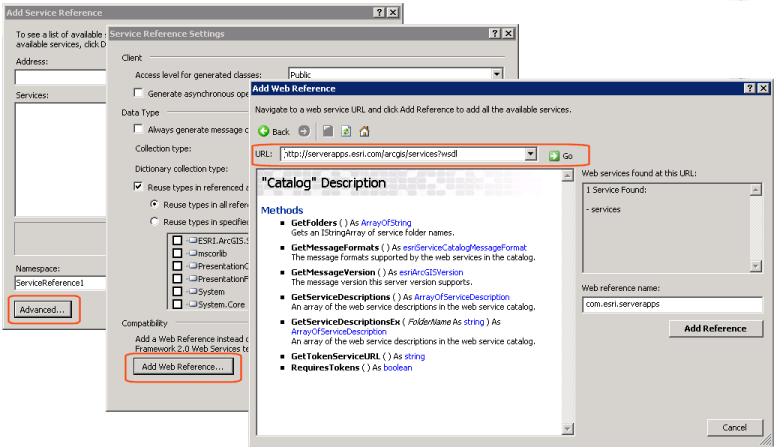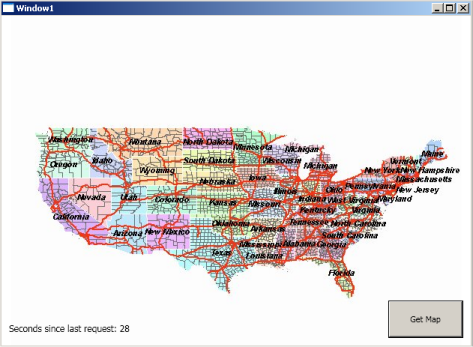Use the AGSSOAPUtility class included
with the sample download to authenticate the user credentials. The
source code for the class is included below. In
general, the workflow is as follows:
a. Construct an Web request to GET the WSDL for an ArcGIS Server SOAP
Web service.
b. Try to get the response (which initiates the request). If
an exception is thrown, check the error code. If
unauthorized (401) assign credentials to the Web request. If
a token is required (499) or expired/invalid (498), generate a token and
add it to the Web request Url.
c. If HTTP\Windows authentication, assign credential to the ArcGIS
Server SOAP Web proxy class. If token-based authentication,
add the token to the Url for the ArcGIS Server SOAP Web proxy class. Return
the proxy class to the caller.
The follow AGSSOAPUtility.cs assumes you are using the pre-generated proxy classes
in the ESRI.ArcGIS.SOAP.dll.
using
System;
using
System.Collections.Generic;
using
System.Linq;
using
System.Text;
using
System.Net;
using
ESRI.ArcGIS.SOAP;
using
System.Collections.Specialized;
namespace
AGSSOAPUtility
{
class
AuthenticateProxy
{
public
static System.Web.Services.Protocols.SoapHttpClientProtocol
Authenticate(System.Web.Services.Protocols.SoapHttpClientProtocol
serviceproxy,
string
username, string password, string domain, int timeout)
{
string
url_401 = serviceproxy.Url;
if
(serviceproxy.Url.Contains("?"))
url_401
= serviceproxy.Url.Substring(0, serviceproxy.Url.IndexOf("?"));
url_401
+= "?wsdl";
HttpWebRequest
webRequest_401 = null;
webRequest_401
= (HttpWebRequest)HttpWebRequest.Create(url_401);
webRequest_401.ContentType
= "text/xml;charset=\"utf-8\"";
webRequest_401.Method
= "GET";
webRequest_401.Accept
= "text/xml";
HttpWebResponse
webResponse_401 = null;
while
(webResponse_401 == null || webResponse_401.StatusCode != HttpStatusCode.OK)
{
try
{
webResponse_401
= (HttpWebResponse)webRequest_401.GetResponse();
}
catch
(System.Net.WebException webex)
{
HttpWebResponse
webexResponse = (HttpWebResponse)webex.Response;
if
(webexResponse.StatusCode == HttpStatusCode.Unauthorized)
{
if
(webRequest_401.Credentials == null)
{
webRequest_401
= (HttpWebRequest)HttpWebRequest.Create(url_401);
webRequest_401.ContentType
= "text/xml;charset=\"utf-8\"";
webRequest_401.Method
= "GET";
webRequest_401.Accept
= "text/xml";
webRequest_401.Credentials
= new NetworkCredential(username, password, domain);
}
else
{
//
if original credentials not accepted, throw exception
throw
webex;
}
}
//
499 - token required, 498 - invalid token
else
if (webexResponse.StatusCode.ToString() == "499" ||
webexResponse.StatusCode.ToString()
== "498")
{
string
tokenServiceUrl = "";
ServiceCatalogProxy
myCatalog = new ServiceCatalogProxy();
myCatalog.Url
= serviceproxy.Url.Substring(0, serviceproxy.Url.IndexOf("/services")
+ 9);
if
(myCatalog.RequiresTokens())
tokenServiceUrl
= myCatalog.GetTokenServiceURL();
else
throw
new Exception("Service does not require token but status code 499
returned");
if
(string.IsNullOrEmpty(tokenServiceUrl))
throw
new Exception("Token service url unavailable");
string
url = tokenServiceUrl +
string.Format("?request=getToken&username={0}&password={1}&timeout={2}",
username,
password, timeout);
System.Net.HttpWebRequest
request = (HttpWebRequest)System.Net.WebRequest.Create(url);
System.Net.WebResponse
response = request.GetResponse();
System.IO.Stream
responseStream = response.GetResponseStream();
System.IO.StreamReader
readStream = new System.IO.StreamReader(responseStream);
string
theToken = readStream.ReadToEnd();
webRequest_401
= (HttpWebRequest)HttpWebRequest.Create(url_401 + "&token="
+ theToken);
}
else
{
//
if status code unrecognized, throw exception
throw
webex;
}
}
catch
(Exception ex) { throw ex; }
}
if
(webResponse_401 != null)
webResponse_401.Close();
if
(webRequest_401.Credentials != null)
serviceproxy.Credentials
= webRequest_401.Credentials;
if
(webRequest_401.RequestUri.ToString().Contains("token"))
{
string
myToken =
ParseStringIntoNameValueCollection(webRequest_401.RequestUri.ToString())["token"];
string
baseServiceProxyUrl = serviceproxy.Url;
if
(serviceproxy.Url.Contains("?"))
baseServiceProxyUrl
= serviceproxy.Url.Substring(0, serviceproxy.Url.IndexOf("?"));
serviceproxy.Url
= baseServiceProxyUrl + "?token=" + myToken;
}
return
serviceproxy;
}
private
static System.Collections.Specialized.NameValueCollection
ParseStringIntoNameValueCollection(string
argumentValues)
{
System.Collections.Specialized.NameValueCollection
keyValColl =
new
System.Collections.Specialized.NameValueCollection();
string[]
keyValuePairs = argumentValues.Split(new char[] { '&' },
StringSplitOptions.RemoveEmptyEntries);
for
(int i = 0; i < keyValuePairs.Length; i++)
{
string
keyval = keyValuePairs[i];
int
index = keyval.IndexOf('=');
if
(index >= 0)
{
string
key = keyval.Substring(0, index);
string
val = keyval.Substring(index + 1);
keyValColl.Add(key,
val);
}
}
return
keyValColl;
}
}
}

